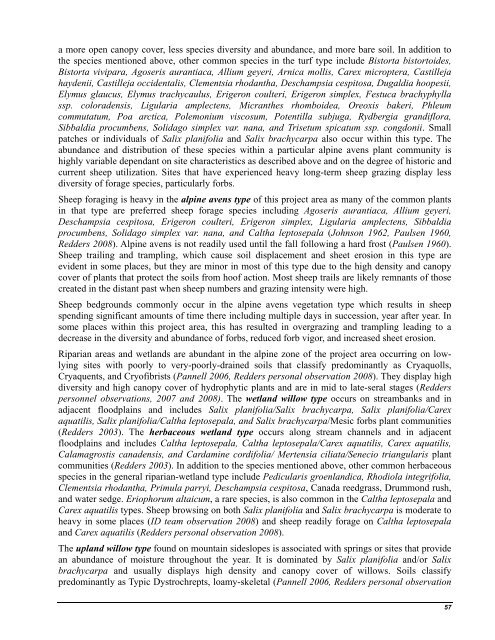NEPA--Environmental Assessment
NEPA--Environmental Assessment
NEPA--Environmental Assessment
Create successful ePaper yourself
Turn your PDF publications into a flip-book with our unique Google optimized e-Paper software.
a more open canopy cover, less species diversity and abundance, and more bare soil. In addition to<br />
the species mentioned above, other common species in the turf type include Bistorta bistortoides,<br />
Bistorta vivipara, Agoseris aurantiaca, Allium geyeri, Arnica mollis, Carex microptera, Castilleja<br />
haydenii, Castilleja occidentalis, Clementsia rhodantha, Deschampsia cespitosa, Dugaldia hoopesii,<br />
Elymus glaucus, Elymus trachycaulus, Erigeron coulteri, Erigeron simplex, Festuca brachyphylla<br />
ssp. coloradensis, Ligularia amplectens, Micranthes rhomboidea, Oreoxis bakeri, Phleum<br />
commutatum, Poa arctica, Polemonium viscosum, Potentilla subjuga, Rydbergia grandiflora,<br />
Sibbaldia procumbens, Solidago simplex var. nana, and Trisetum spicatum ssp. congdonii. Small<br />
patches or individuals of Salix planifolia and Salix brachycarpa also occur within this type. The<br />
abundance and distribution of these species within a particular alpine avens plant community is<br />
highly variable dependant on site characteristics as described above and on the degree of historic and<br />
current sheep utilization. Sites that have experienced heavy long-term sheep grazing display less<br />
diversity of forage species, particularly forbs.<br />
Sheep foraging is heavy in the alpine avens type of this project area as many of the common plants<br />
in that type are preferred sheep forage species including Agoseris aurantiaca, Allium geyeri,<br />
Deschampsia cespitosa, Erigeron coulteri, Erigeron simplex, Ligularia amplectens, Sibbaldia<br />
procumbens, Solidago simplex var. nana, and Caltha leptosepala (Johnson 1962, Paulsen 1960,<br />
Redders 2008). Alpine avens is not readily used until the fall following a hard frost (Paulsen 1960).<br />
Sheep trailing and trampling, which cause soil displacement and sheet erosion in this type are<br />
evident in some places, but they are minor in most of this type due to the high density and canopy<br />
cover of plants that protect the soils from hoof action. Most sheep trails are likely remnants of those<br />
created in the distant past when sheep numbers and grazing intensity were high.<br />
Sheep bedgrounds commonly occur in the alpine avens vegetation type which results in sheep<br />
spending significant amounts of time there including multiple days in succession, year after year. In<br />
some places within this project area, this has resulted in overgrazing and trampling leading to a<br />
decrease in the diversity and abundance of forbs, reduced forb vigor, and increased sheet erosion.<br />
Riparian areas and wetlands are abundant in the alpine zone of the project area occurring on lowlying<br />
sites with poorly to very-poorly-drained soils that classify predominantly as Cryaquolls,<br />
Cryaquents, and Cryofibrists (Pannell 2006, Redders personal observation 2008). They display high<br />
diversity and high canopy cover of hydrophytic plants and are in mid to late-seral stages (Redders<br />
personnel observations, 2007 and 2008). The wetland willow type occurs on streambanks and in<br />
adjacent floodplains and includes Salix planifolia/Salix brachycarpa, Salix planifolia/Carex<br />
aquatilis, Salix planifolia/Caltha leptosepala, and Salix brachycarpa/Mesic forbs plant communities<br />
(Redders 2003). The herbaceous wetland type occurs along stream channels and in adjacent<br />
floodplains and includes Caltha leptosepala, Caltha leptosepala/Carex aquatilis, Carex aquatilis,<br />
Calamagrostis canadensis, and Cardamine cordifolia/ Mertensia ciliata/Senecio triangularis plant<br />
communities (Redders 2003). In addition to the species mentioned above, other common herbaceous<br />
species in the general riparian-wetland type include Pedicularis groenlandica, Rhodiola integrifolia,<br />
Clementsia rhodantha, Primula parryi, Deschampsia cespitosa, Canada reedgrass, Drummond rush,<br />
and water sedge. Eriophorum altaicum, a rare species, is also common in the Caltha leptosepala and<br />
Carex aquatilis types. Sheep browsing on both Salix planifolia and Salix brachycarpa is moderate to<br />
heavy in some places (ID team observation 2008) and sheep readily forage on Caltha leptosepala<br />
and Carex aquatilis (Redders personal observation 2008).<br />
The upland willow type found on mountain sideslopes is associated with springs or sites that provide<br />
an abundance of moisture throughout the year. It is dominated by Salix planifolia and/or Salix<br />
brachycarpa and usually displays high density and canopy cover of willows. Soils classify<br />
predominantly as Typic Dystrochrepts, loamy-skeletal (Pannell 2006, Redders personal observation<br />
57

















